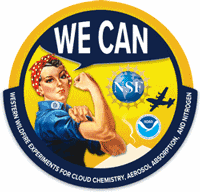A .gov website belongs to an official government organization in the United States.
A lock () or https:// means you've safely connected to the .gov website. Share sensitive information only on official, secure websites.
Experiments at the USDA Fire Sciences Lab in Missoula, Montana in 2016 focus on refining our understanding of emissions and short timescale processing using the instruments and methods that have been developed during the first years of FIREX (Fire Influence on Regional and Global Environments Experiment, which evolved into FIREX-AQ). The focus is on measuring fuels or combustion conditions that are characteristic of the western U.S. that may be under-sampled by the fire research community and in the follow-up study of fuels from fires observed during the 2019 intensive field study.
 Western wildfire Experiment for Cloud chemistry, Aerosol absorption and Nitrogen (WE-CAN)
Western wildfire Experiment for Cloud chemistry, Aerosol absorption and Nitrogen (WE-CAN)The NCAR/NSF sponsored field study in July and August 2018 will systematically characterize the emissions and first day of evolution of western U.S. wildfire plumes. The project will focus on three sets of scientific questions related to fixed nitrogen, absorbing aerosols, cloud activation and chemistry in wildfire plumes. The data will be collected from the NCAR/NSF C-130 research aircraft.
 Fire and Smoke Model Evaluation Experiment (FASMEE)
Fire and Smoke Model Evaluation Experiment (FASMEE)FASMEE offers the opportunity to sample one or more large prescribed fires planned and executed by Joint Fire Science Program (JFSP) partners. This objective will take priority when and if burns are announced. Planned and controlled burns are of special interest, because maximum information will be available on the variables affecting fire behavior, development, dynamics, and emissions. Along with the information gathered before, during, and after the fire, airborne observations gathered during FASMEE provide the best chance for bridging laboratory and ambient fires. Fuels from potential FASMEE burn sites were burned during the FIREX FireLab 2016 intensive experiement.